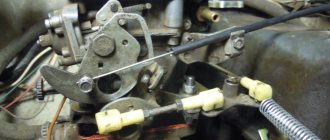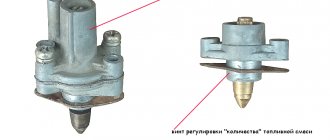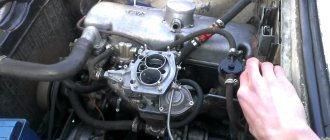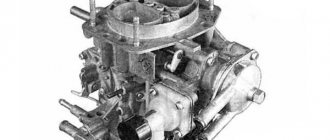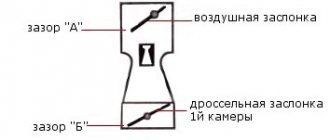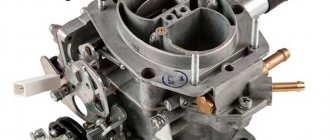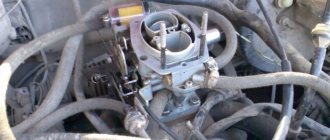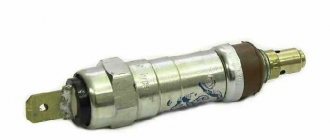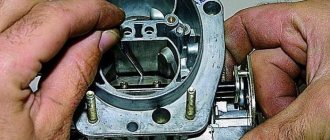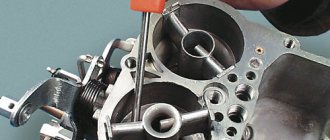Solex automobile carburetors have gained great popularity due to the ability to create various modifications of this device. This versatility is achieved by grooved diffusers. However, to a greater extent they are used on power units with a volume of less than 1500 cm3. Sometimes there is a need to become familiar with the operating principle and adjustment features of such units.
Solex carburetor design
The Solex carburetor has several models, namely:
The main modification of this brand of carburetors is SOLEX 21083. This model has the smallest diffuser cross-section. In terms of structure, all Solex models are the same, there are only some differences (different brands and models of cars have their own modification). Therefore, the Solex settings for all models are the same.
The Solex carburetor type is emulsion. It is installed only on cars with engines with contactless ignition.
Solex device:
- two chambers with throttle valves;
- chamber dosing system;
- transition systems for both chambers;
- idle speed system only for the first chamber.
Classification of Solex carburetors by configuration:
- Semi-automatic starting system.
- Carburetor accelerator pump.
- Power mode economizer.
Have you heard about a car device that can reduce fuel consumption, the FuelFree fuel saver?
Let's sum it up
The steps described above for setting up and adjusting a Solex carburetor are basic. In other words, if you wish, you can adjust the carburetor yourself, based on this information. Note that the accuracy of the settings can be further checked on a gas analyzer, after which you can make the necessary adjustments yourself instead of constantly contacting specialists. Finally, we add that a dosing device of this type lends itself to various types of tuning, all kinds of modifications and improvements. For this reason, when choosing a carburetor for a VAZ, it is not for nothing that many car enthusiasts prefer Solex.
How to set up a Solex carburetor
The best carburetor is SOLEKS. Therefore, many drivers replace their standard carburetors with devices of this type. Solex works clearly even if there was a strong overflow of fuel. As it turned out, many people have difficulties in correctly setting up the Solex carburetor. It must be configured so that fuel consumption is minimal and power is maximum, so you need to look for the “golden mean”. Therefore, those who do not want to learn the subtleties and nuances of setting up give this job to a professional.
But, for those who want to learn how to adjust and configure a Solex carburetor, we will describe the correct procedure:
- It is necessary to set the level in the float chambers. The manual (instructions) states that the level can be set using a special template. This is difficult if there is no factory setting. If there is no factory setting, you need to do it yourself. How to do it? To do this, start the internal combustion engine and warm it up for about 10 minutes. Next, turn off the engine and disconnect the fuel supply hose. When the hose is disconnected, gasoline flows out normally, but fuel must not be poured into the chamber, otherwise the readings will be spoiled. Next, unscrew the carburetor cover bolts and remove the choke cable. After disconnecting the cable, you must very carefully and horizontally remove the Solex carburetor cover. If you do this carelessly, the floats may be damaged. Now you need to measure the distance from the Solex cap to the surface of the gasoline. It is necessary to measure in each chamber; the fuel level in them may be different. To determine whether the level is normal or not, you need to add the two resulting distances and divide by 2, that is (distance of camera 1 + distance of camera 2)/2. If the measured distance is between 25 and 35 mm, then everything is normal. If the level goes beyond the limits up or down, then you need to adjust the level. To do this, bend the float in the desired direction and drain some of the fuel.
- We adjust the idle speed of the internal combustion engine. It often happens that when you press the clutch pedal, the engine speed immediately drops - this indicates that the idle speed has disappeared. To do this, warm up the car engine to normal operating temperature. Next, turn off the engine. In the hole in the Solex sole we look for the mixture quality screw and turn it to the right until it stops. Now you need to start the internal combustion engine and push in (remove) the choke. This screw is used to set the permissible minimum speed. This number of revolutions should ensure stable, stable operation of the motor, while the vacuum should be minimal. A well-tuned Solex carburetor should allow the engine to idle at speeds from 500 to 1200 rpm. After the engine begins to operate stably, we continue to rotate the mixture quality screw until the internal combustion engine begins to operate unstably, after which we turn it back 1-2 turns. Next, we proceed to setting the engine speed to normal; we need to make sure that the speed is in the range from 800 to 900 rpm. Turn the screw until the engine starts running stably.
- When adjusting the idle speed, beginners often have difficulties. It happens when you turn the quality screw, the engine operation does not change, but the quality of the internal combustion engine must change. When the engine is unstable, the mixture quality screw can be adjusted. If the engine does not respond to changes in the adjustment of this screw, then fuel continues to flow into the idle channel, the screw cannot close it. This may be due to an enlarged nozzle (hole for metered fuel supply) or due to a poorly screwed plug, as well as a deformed nozzle. This can be done by carrying out a simple diagnostic procedure: with the engine running, you need to unscrew the valve - here the engine should stall. If the problem is in the enlarged nozzle, then the internal combustion engine will suddenly turn off, and if the internal combustion engine does not stall at all, then gasoline is not supplied through the nozzle. In this case, when the engine does not stall with the carburetor valve removed, then we check the stopper screw of the second chamber. The locking screw is used to smoothly open the throttle valve.
Reasons for increased consumption
Increased fuel consumption on the VAZ 2109 carburetor is the most important reason for car enthusiasts who ask questions about adjusting and repairing carburetors. So:
- Moreover, they all want to know how to make a carburetor economical in a VAZ 2109. While walking, many have no idea how to correctly determine fuel consumption
- Their mistake is that they take the operating gasoline consumption as the reference
- This is a big mistake
- The reasons for increased fuel consumption are:
- Inaccuracies in the readings of the device that monitors the fuel level in the tank, as well as errors in the speedometer and driving style (increasing consumption), which is typical for most young motorists
- They pour 10 liters into the tank and set the daily counter to zero, drive with engine warm-ups, stops, both on city roads and on the highway, while they want to drive 120 kilometers, which you will agree is stupid
- If any of you have ever installed a measuring cup (measuring container) when warming up the engine, especially during suction in the winter cold, then you know that the liter measuring cup is emptying before your eyes
- You can find out the fuel consumption of your car from the documentation; it is indicated, as a rule, for three main operating conditions - this is 90 kilometers per hour, then 120 kilometers per hour and city driving
- At the same time, the most economical mode is driving on a relatively flat road, the speed does not exceed 90 kilometers per hour, and using fifth gear, this is driving with the first chamber of the carburetor open
- If you increase the speed to 120 kilometers per hour, then the second chamber opens and fuel consumption naturally increases by 1-2 liters on average per 100 kilometers.
How to check Solex
To ensure high-quality work on adjusting and tuning the carburetor, you should ensure that sand particles, etc. do not get on the throttle valves. If solid particles get into the carburetor, this can lead to an expensive overhaul of the internal combustion engine (due to some small thing).
After you have adjusted the carburetor correctly, you need to check the accelerator pump. When the throttle valve is opened slightly, the nozzle should spray gasoline. Here is the answer to the question: why does the car jerk when driving? If a stream of gasoline from the sprayer appears late, then this precisely leads to braking when you press on the gas and the car jerking.
To clean the carburetor, it must be disassembled. First, we unscrew the fuel and air jets, as well as the emulsion tubes. If it is difficult to remember what is where in the carburetor device, then it is most convenient to photograph each step.
To determine whether the diaphragm is intact, unscrew the cap of the power mode economizer.
Signs of a broken carburetor diaphragm:
- The internal combustion engine does not stall when the screw is tightened.
- If you turn off the ignition, the engine continues to run for some time, that is, self-ignition occurs.
- Unstable operation of the internal combustion engine.
- Increased gas mileage during normal, moderate driving.
ECTO or EURO? What brand of fuel is best to fill in? ECTO fuel is not recommended for use in cars with high mileage.
After checking the integrity of the diaphragm, we clean the SOLEKS. For cleaning we use air pressure (a compressor or pump is needed). If the dirt is hard and does not fly off with a stream of air, then carefully clean the stuck dirt with copper wire. I use air pressure cleaning without damaging the surfaces of carburetor parts. After this, close the lid and now you need to lubricate all the rubbing surfaces of the carburetor parts. It should be lubricated after washing the outer part.
Preparing tools and devices
If you intend to thoroughly clean the carburetor of your V8, then you will not be able to do it without a compressor. To blow out accumulated dirt from the channels, it is necessary to supply air at a pressure of at least 6 bar. The remaining tools are common ones found in every garage:
- 2 screwdrivers - Phillips and thin with a narrow flat slot;
- a set of small open-end wrenches - 8, 10, 13 mm;
- round nose pliers;
- rubber bulb (syringe);
- 2-3 wooden toothpicks;
- rags.
Compressor for carburetor purging
Liquids for cleaning carburetor channels
A special product sold in aerosol cans (for example, from the ABRO brand) is excellent for cleaning channels. Do not use acetone or inorganic solvents, which corrode plastic parts, for cleaning. Buy new paper gaskets for DAAZ 2108 carburetors in advance (they will also fit the “nine”). You cannot buy or change jets, since the standard ones are designed for the entire service life of the machine, and fakes with large holes for fuel are often sold in repair kits.
Solex carburetor tuning
Tuning, that is, improvement, modification of the carburetor is carried out to increase engine power and improve driving dynamics.
Important! In order to achieve maximum power, there must be a minimum of resistance at the carburetor inlet. With high resistance, the quality of the mixture is not always “at its best” (sometimes “poor”, sometimes “rich”).
If you sharply open the throttle valve with the Solex carburetor set at the factory, the air flow speed decreases, as a result of which less gasoline is supplied to the carburetor. Because of this, power drops significantly at low speeds.
The procedure for increasing engine power by tuning the Solex carburetor:
- We carefully disassemble the carburetor.
- We wash and blow, and divide into two halves.
- Pay attention to the air damper axis. There are protruding screws on this axis, which creates additional resistance while the car is moving. Any little things are important when tuning, so these protruding screws need to be smoothed out.
- Remove the axle and air damper from the top. The axle needs to be sharpened.
- From the lower part you need to pull out the throttle valves with their axles. At this stage, using a file we make the flaps larger. We hide the screw caps inside the axle. There are screws with conical heads, you can use them. The throttle valve needs to be assembled.
- Now we are tuning the diffusers. To improve the aerodynamics of the diffusers, it is necessary to make the legs in the shape of wings. We also check the protrusions of the factory casting; if there are any, they need to be ground off.
- The accelerator pump must have 2 tubes installed in one chamber. There is an opinion among some that when I use two tubes for each camera, “dips” may appear, that is, you press on the gas, but the car does not move.
In general, the basis of tuning is smoothing, erasing protrusions and irregularities. Any unevenness in the fuel and air mixing chamber creates resistance.
Video
This video shows how to clean a Solex carburetor
This video is about tuning the small diffuser of a Solex carburetor
This is a general video on improving the SOLEX carburetor.
With the development of the automotive industry, older models of carburetors were replaced by carburetors with the Solex brand. Unlike their counterparts, Solex delivers more accurately and helps the car develop more power. Such carburetors are installed on engines with a displacement of 1.5 liters, front-wheel drive VAZ cars, the Samara family: VAZ 2108; 2109, 21099, 2110.
Solex carburetor design VAZ 21083
The Solex VAZ 21083 two-chamber carburetor is installed on naturally aspirated engines of VAZ 21083 cars. It consists of a cover and a main body, which includes:
- Float chamber.
- Starting system.
- Idle system with solenoid valve.
- Main dosing system.
- Transitional system.
- Economizer with accelerator pump.
- Econostat.
Fuel is supplied from the float chamber through special channels through fuel nozzles, where gasoline is mixed with air, which enters through air nozzles. The combustible mixture then flows through the carburetor diffusers directly into the engine. The throttle valve drive on this carburetor is mechanical and varies depending on the force of pressing the accelerator pedal. The carburetor provides for adjustment of the combustible mixture using quantity and quality screws.
Jet markings
For each carburetor system, jets of different cross-sections are provided, so during repairs it is important to know what cross-section the fuel or air jet is needed. When purchasing a car, it comes with a service book, which outlines the main characteristics and its structure, as well as a jet marking scheme depending on the carburetor model.
The main metering system has fuel jets marked 80 or 95 for the primary chamber and 100 for the secondary. There are also air jets 150, 155, 165 for the primary chamber and jet 125 for the secondary. The idle system includes fuel nozzles marked 38-44 and 50, and air nozzles 170 and 160. In the secondary chamber of the transition system, fuel nozzles 50 and 80, and air nozzles 120 and 150. For the main metering system, a fuel nozzle 85 is provided.
Adjusting the carburetor Solex VAZ 21083
For the carburetor to work properly, it must be properly adjusted and configured. This kind of work is not difficult to do with your own hands, you just need to be careful and don’t be afraid to make adjustments yourself.
To adjust the quality of the fuel mixture, you need to first warm up the engine to its operating temperature, then turn the fuel mixture quantity screw to set it to 800-900 rpm. Now, using a flat screwdriver, you need to gradually unscrew the quality screw until the motor starts up. Afterwards, the quality screw is very carefully tightened until the engine runs smoothly.
There are cases when, with such an adjustment, the engine operation remains the same and does not change. This is possible for several reasons:
- contamination of the quality screw channel;
- contamination of the fuel jet of the solenoid valve;
- Solenoid valve malfunction.
The solenoid valve may not work due to a broken chip or wires going to the valve, or due to a malfunction of the core itself. In this case, the valve is replaced with a new one, the dirty channels and jets are cleaned with compressed air.
Adjustment of the fuel level in the float chamber is carried out on the removed top cover of the carburetor, by bending the plate that holds the floats. Each float is measured with a special probe so that the gap between the float itself and the surface of the cover is within 1-1.5 mm. Precise adjustment of the floats will ensure constant maintenance of the fuel level and its uninterrupted supply. In addition, it is worth adjusting the tension of the air and throttle cables so that the engine can start in winter and run without interruptions.
Adjusting the tension of the air damper cable is carried out with the air choke pulled out from inside the car, tensioning and fixing the position of the cable on the damper drive. The tension of the throttle cable is also adjusted, that is, when the gas pedal is released, it should be closed.
Correct setting of the Solex VAZ 21083 carburetor will ensure a rational dosage of the combustible mixture at any engine speed, without excessive fuel consumption.
There are many different modifications of Solex carburetors, while the 21083 series is the basic version with a minimal diffuser cross-section. This model is usually installed on 1.5-liter engines of VAZ cars. We previously wrote about the “Ozone” setting on models 2106 and 2107.
The enormous popularity of this series is due to the possibility of grooving diffusers. Thus, almost any modification to the carburetor can be made. Experts do not recommend installing Solex on engines with a volume of more than 1.5 liters, as in this case the engine will be “choked” at high speeds. If you intend to configure this carburetor for the UZAM power unit, it is necessary to replace the jets due to the fact that a richer fuel mixture must be provided.
Setting up Solex
Adjusting the fuel level . Setting up a Solex carburetor usually begins with setting the required level in the float chamber. To do this, you must first start the engine and warm it up for 5 minutes. After this, turn off the engine and perform the following operations:
- Carefully disconnect the fuel supply hose.
- Unscrew the 5 screws that secure the carburetor cover.
- Disconnect the choke system cable.
- Carefully lift the lid to avoid damaging the floats.
- Using a ruler, or better yet a caliper, measure the fuel level in the chamber.
Recommended Method
Level control technology includes a number of stages:
- We dismantle the housing of the air filter element. To do this, unscrew the fastening nut of the housing cover, unclip the latches, remove the cover, take out the filter and tighten the 4 nuts that secure the housing to the carburetor.
- Raise the body and disconnect the rubber pipes. We move the body to the side.
- Loosen the clamps securing the fuel pipes going to the carburetor and disconnect them.
- Remove the wire suitable for the idle speed solenoid valve;
- Disconnect the drive cable of the air damper (the “choke” handle);
- Unscrew the 5 screws securing the carburetor cover;
- Having removed the cover, we immediately determine the fuel level in the chambers by lowering a ruler or caliper into one of them until it stops (using its depth gauge). If the measurement shows a level of 25-26 mm, it corresponds to the norm and no adjustment is required;
If the amount of fuel in the chamber is lower or higher than normal, we perform a visual inspection and a series of measurements on the floats, and if necessary, we correct their position.
To carry out adjustment work, place the removed carburetor cover on a flat horizontal surface with the floats facing up.
First, we look at the position of the elements from above. The outer side surfaces of the floats are parallel to the special imprints on the gasket. Deviations can cause the floats to touch adjacent elements and surfaces, causing the fuel level to be incorrect. If necessary, adjust the position of the floats by bending their mounting arms. The next step is to measure the gap between the floats and the gasket. A rod with a diameter of 2 mm is useful here - this is how much the specified gap should be.
If it does not correspond, we bend the tongue of the floats, with which they act on the locking needle. After this adjustment, we check the total height of the floats, which is normally 34 mm. If this is not the case, check the gap again, adjust it if necessary and measure the height again.
The last stage of setup is determining the working stroke of the floats. To do this, place a caliper near the float, mark the distance from its lower corner to the surface of the cover, then lift the float with your hand and mark where the lower corner is.
A working stroke of 15 mm is considered normal; if it differs, it is adjusted by bending the tongue.
Possible problems when setting up XX
When the quantity screw is tightened, the engine does not react at all . This problem can occur when a large amount of fuel enters the idle diffuser. There may be several reasons for this:
- an XX jet of a larger size than necessary is installed;
- the plug or solenoid valve is not tightened properly, so gasoline is sucked in, bypassing the XX jet;
- The jet or its seat is deformed.
To identify the specific cause of the above problem, it is necessary to disconnect the wire from the valve while the engine is running, and the motor should immediately turn off. If this happens, most likely the wrong size XX jet is installed. When the engine does not stall when the power supply to the valve is turned off, it means that fuel is supplied bypassing the exhaust system, including the nozzle itself.
To eliminate the malfunction, first remove the plug or solenoid valve and check the condition of the nozzle and seat for any deformations. If the seat is damaged, you will have to replace the carburetor cover. If no damage or deformation is detected, put the jet on the solenoid valve and lubricate the o-ring with oil. Then we tighten the nozzle with a wrench, holding it with one finger without much effort.
Basic faults
Despite the fact that Solex is considered almost the most reliable carburetor, it also periodically fails. Main faults:
- The nozzle of the main dosing system becomes clogged;
- The idle jet in the solenoid valve is clogged;
- The carburetor body overheats and becomes deformed;
- The accelerator pump fails (cracks and ruptures of the diaphragm);
- The solenoid valve comes off the thread;
- The diffusers in the housing are loose.
Clogged jets can be removed by cleaning and purging. This is perhaps the simplest thing that can happen to a carburetor, and you won’t need to spend any special money or time on repairs.
Hull deformation is a more serious problem. In some cases, grinding the top surface helps to eliminate air leaks. But if the case is badly damaged, only replacement will help; no grinding will do.
You can check the condition of the diaphragm visually, and this is also not difficult, since the accelerator pump is located on the housing under a separate cover. Removing the cover, inspecting the pump diaphragm and, if necessary, replacing it is a task that even a non-specialist can do.
The solenoid valve has the property of “self-unscrewing”, which is why gasoline begins to be sucked under the thread, which means the mixture becomes over-rich. There are several reasons: the thread becomes loose, the rubber seal fails, or the valve was not initially turned all the way. If the valve itself is in order, you need to tighten it all the way. If you change the seal at the same time, you will have to tighten the valve with a wrench to make sure it fits in place.
One of the common options for tuning a carburetor is replacing or boring diffusers. This way you can achieve better filling of the cylinders with the fuel-air mixture, which means greater power output from the engine. At the same time, the diffusers themselves suffer from vibration and can periodically become loose in their seats. In this case, you will need to disassemble and calibrate the carburetor, sometimes with replacement of the diffusers themselves.
How to choose jets?
The selection of jets for Solex 21083 is made taking into account the engine size. Experts recommend starting the selection with a fuel nozzle for the first chamber. Having selected the desired sample, we select the corresponding air analogue for it. And then in the same order we select the jets for the second chamber. First you need to look for a factory carburetor designed for the size of your engine, remove the jets from it and take them as a reference point. Further selection of jets is made according to this principle. If you need to lean the mixture a little, choose a larger jet by one pitch. If you want to enrich it, use a smaller jet.
Emulsion hoses are assembled along with the jets. These tubes are designed to adjust the composition of the fuel mixture in accordance with engine speed. There are three types of tubes: 23, ZC and ZD. The first are used for Solex 21083 carburetors installed on transverse chisel engines. For the first chamber of carburetors of UZAM power units, ZD tubes are used, and for the second - ZC.
